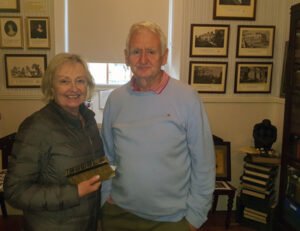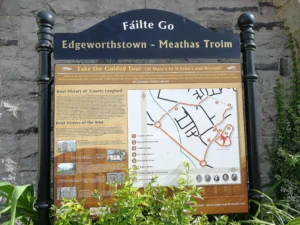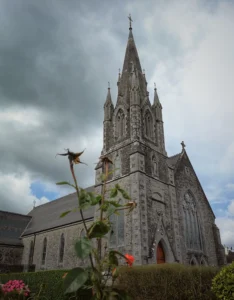


A visitor to our town – Patrick Dunne – wrote of his visit to the historical sites in Longford and how his pre-conceived notions about Edgeworthstown were changed as a result of his visit. He has written an article about this and we’re grateful for his permission to reproduce the article below.
By: Patrick Dunne
Tuesday evening at about 10:30 pm I recalled the instruction as the car took me through the dark and winding back roads of North Kildare. ‘Visit somewhere that you are not familiar with and record a scenic description, write a story inspired by it’… It sounded like a fun assignment but I could feel the challenger, The Pusher in my head trying to get his usual spoke in to make things more difficult. But I pushed him back. I could surrender myself to the solitude of a seaside setting or maybe do a tourist thing in town, the Guinness storehouse or a museum time-out perhaps. I could get a nice story going there.
“That would make the assignment too easy” The Pusher whispered a bit louder. “Take the train in the other direction like you’ve always wanted to do on those rush hour mornings”. I turned up the volume on the Sigur Ros cd hoping he’d go away.
He didn’t.
“Think of the towns on that route…Kilcock, Enfield, Mullingar, Edgeworthstown. There you go! Never been to Edgeworthstown have you?” he pushed. “Never seen the historical sites in Longford?”
“Oh I wonder why” I replied with a scoff. “I could write it now.”
I’m standing in the rain on a street in Edgeworthstown Co Longford, the only street in the town as far as I can see; I could be in almost any small midland town in Ireland, no character to speak of, no story to tell. It’s cold, dull and the clouds are even greyer than the cracked concrete underfoot. Drab, uninspiring two-storey flat faced buildings yawn at each other across a narrow litter strewn street. Sour faced locals trudge along with heads down, sad that their bypassed town is dying.
“That’s hardly fair now is it? And besides, it’s cheating, you haven’t been there”. The pusher was being bossy.
‘If you would study and admire her as she deserves, you must see her at home’ (Sir William Hamilton)
At 10 am on Wednesday morning I googled Edgeworthstown. The first line from Longford tourism read:
A small but spirited community town located on the N4 and therefore within easy reach of many of the larger towns and counties.
Hardly inspiring! The best thing about Edgeworthstown is its proximity to other places!
“Read on.” The Pusher ordered.
Hang on What’s this?…
The town is most famous for its association to the celebrated author Maria Edgeworth and her family. Amongst the eminent members of the Edgeworth family who first made their home here in 1583, was Richard Lovell Edgeworth, ingenious inventor and surveyor and father of 22 children, one of whom was Maria.
At this point I was interested and more than a little ashamed by my earlier ignorance. I had never before associated the town with the author, there was bound to be a story attached to your man with the 22 kids and besides, after reading a brief history of her life and work, I was strangely attracted to Maria.
She seemed smart, mischievous and mysterious but mindful and caring. Her written work had been admired in the past by acclaimed authors such as Jane Austen, Lord Byron and Walter Scott amongst others. She was a huge commercial success in her life time and there was a suggestion that Austen may have been a little jealous or at least influenced by and in awe of Maria. As to why things later changed may be due to Victorian attitudes at the time or a discomfort with Maria’s satirical style and strong political commentary. Or perhaps it was because Maria lived in a quiet midland town in Ireland.
I clicked on a link to the dedicated and professionally presented website of the Edgeworth’s Society. I spent the next two hours reading about Edgeworthstown, the fascinating Edgeworth family history and about Maria and her writings; intriguing, varied and much more extensive than her famed novel ‘Castle Rackrent’. The annual literary festival and historical town walking tour with its visit to historical sies in Longford caught my attention. There were also references of associations with the town to Oliver Goldsmith, Oscar Wilde and others.
Wilde’s sister Isola died from meningitis just 2 weeks short of her 10th birthday while on an extended stay with her aunt and uncle in the town. Her aunt was her father’s sister and was married to Rev. William Noble. They lived in the rectory in the town and Isola often visited with them. Wilde, deeply saddened by his sister’s passing, later wrote the beautiful poem, Requiescat, in her memory.
To prepare him for college Goldsmith was sent to school in Edgeworthstown under the supervision of Rev. Patrick Hughes. Although not factually confirmed, it is likely that he resided in the rectory during that time. Reports suggest that Oliver was not a brilliant student, even a little careless at times.
Maria lived from 1768 until 1849 at a time when it was not considered appropriate to educate women in the same way or to the same level as men. Not only did she overcome that barrier but she sought, helped to fund and worked towards the development of children’s education both locally and further afield through her writings. Her early work ‘Practical Education’ written with support from Richard is an innovative and progressive theory of education for young children.
I spotted a phone number for further information. I rang without stopping to think…To the friendly female voice that answered I must have sounded like an excited child asking for Christmas. In one breath I mentioned; Creative writing course, scenic description, railway line, Maria Edgeworth, Edgeworthstown, History, Goldsmith, Wilde, walking tour of historical sites in Longford, festival. The two seconds of silence before I got a reply was long enough for me to question my own sanity.
“Are you interested in the town or Maria Edgeworth’s work?” the response was welcome but I didn’t know the answer.
“Both” I said and I made a chancing my arm face.
“We’ll ring you back” said the friendly voice…
Ten minutes later the phone rang “Matt Farrell works full time but he would be delighted to meet you for an hour some morning this week. Just let us know when you are coming.” She said enthusiastically.
My short walk around by Maynooth college seminary campus and on to the train station the following morning was interrupted as The Pusher popped in again. “Well isn’t that working out grand now. Your prejudice and ignorance are fixed, you’ll go down, meet the locals, see the town and rewrite that horrible paragraph of putrid perception you had of the town”
Well yes, that’s the plan… I thought.
“And they all lived happily ever after” he scorned. “These people were protestant English landlords, at a time of poverty and famine. She may have been a talented author who supposedly loved her tenants and indeed she wrote a satirical novel or two about English land holders. As for her father, he may have been a kind-hearted inventor who encouraged the peasants to improve themselves. But they both made sure that the rent was coughed up and they watched as thousands took to coffin ships on the Atlantic. I’m sure the locals would have liked to have had time and the ability to write stuff and your man with the 22 kids probably never tended to a child in his life”…The Pusher was being really annoying.
…
“Coming back today?” The ticket seller in Maynooth train station asked.
“Yes, unless I get a better offer” I joked.
“That’ll be €19.70 for a day return to Edgeworthstown. Try the Goldsmith Inn” he smiled.
It was 9 a.m. and 1 degree Celsius in a damp haze. The near platform was crowded with coated commuters cupping Costa coffees and heading to the city. Even though my dodgy knees had to carry me up the slippery steps and across the bridge, I was happy to be heading the other way.
IARNROID EIREANN PLATFORM 2 WESTBOUND TRAINS, the sign said.
I was met at Edgeworthstown train station by Mary, a community development worker and the friendly voice from the phone. Petite, friendly and with short dark hair, I wondered if Mary was a distant relative of Maria. She had taken personal time from her day to collect me and bring me to the community office which is also the location of the old school house. She told me that it was originally funded and developed by Maria Edgeworth and her family and dates from 1840; it is one of the oldest school buildings in the country. I noticed that she called her Maria with the I sounding like an I and not an E. I didn’t argue, I just corrected my pronunciation and fell even more deeply for Maria.
Matt Farrell, a local historian greeted me with a smile and a warm handshake. Matt is the proud and deserved holder of the prestigious title ‘Ireland’s heritage hero’. He is also responsible for the establishment of the Edgeworthstown district development association and the Edgeworth Society. We took a walk and commenced an tour of the town and its historical sites.

We started, strangely I thought, at the Catholic Church; but it is the proximity of the church to the gate lodge of Edgeworthstown house and the residence of the sitting Landlords across the road that is significant. That closeness was most unusual in Irish country towns. The fact that the Edgeworth’s donated land and helped fund the original building on the same site is also noteworthy.
The main house itself, now a care home, is still in place and the gate lodge with its fancy open cast iron front porch has been carefully preserved and is close to its original state. It was also heart-warming to see the old garden, which Maria had tended and loved throughout her lifetime, still fully intact, loved and ready for spring.
All these sights and the slow stroll in between brought questions from me and answers from Matt. His words flow with ease, his pride, love and knowledge of the town’s unique history were infectious. We sauntered on through the garden, the wooden archway and towards the Rectory.
 The old Rectory is a three storey, three bay building and dates from 1735. It is now a mini museum to the Edgeworth family and the town’s other connections to literary and cultural history. There are portraits, artefacts and furniture from the old house, Matt proudly read aloud Maria’s two page hand written note of her father’s will as dictated to her from his death bed. Upstairs is Isola Wilde’s bedroom, preserved as it would have been at the time of her death.
The old Rectory is a three storey, three bay building and dates from 1735. It is now a mini museum to the Edgeworth family and the town’s other connections to literary and cultural history. There are portraits, artefacts and furniture from the old house, Matt proudly read aloud Maria’s two page hand written note of her father’s will as dictated to her from his death bed. Upstairs is Isola Wilde’s bedroom, preserved as it would have been at the time of her death.
I chatted with Matt about Maria and her father Richard Lovell. Their works and creativity, their connection with local people, their charity and local care, their role in local education, the relationship between the two all came up for discussion. We spoke about Maria’s endless efforts in 1847 to relieve the stress and seek relief for the starving victims of the Great Hunger. I heard the story about the aid package from America that found its way to Maria addressed simply; Miss Maria, Ireland.
I still had a niggling question: Was the love between the Edgeworth’s and the local tenants a true and mutual thing or is it a sort of fudged up nice history story?
Matt’s answer came naturally.
In 1798 during the rebellion against British rule in Ireland the Edgeworth’s had fled the country for fear of their lives. A band of rebels supported by French soldiers arrived one night with intention to destroy their home and property. They were met at the gate of the house by locals and other Irish workers from the estate. The house was left unharmed and the rebels retreated.
“And the town name, has there ever been any attempt or pressure to change it?” I asked.
Officially the town name was changed to Mostrim in 1949 but nobody knew where that was. There were stories of parcels and post remaining in the GPO for weeks undelivered, of confused train passengers wondering where this new town came from. There was obviously no great desire or intention from the local people to change it, so it went back to being Edgeworthstown.
We visited another of the historical sites in Longford, the old graveyard at St. Johns Church of Ireland. An iron railing guards the grey stone vault of the Edgeworth family, old faded grave stones stand in solemn support around it and the old church building.
Inscribed on Isola Wilde’s restructured and preserved stone are lines from Oscar’s famous poem. We talked about the church spire and Richard’s innovation regarding it’s build on the ground and subsequent elevation to position. This and other work of his, including the first installation of central heating in a private house in Ireland, his extensive survey of the local bog land, used by Bord Na Mona 100 years later, and his work as an M.P in Grattan’s government must have kept him busy. Hardly much time to tend to his children, I thought.
In her lifetime Maria had a mother and 3 stepmothers, one step mother was the first step mother’s sister and 2 of them were younger than her. With 21 siblings and half siblings it was a busy home and Maria was central to it. She also helped manage her father’s affairs, regarded herself as his secretary and had a firm but fair relationship with the tenants. She dealt with them directly for the most part and she encouraged them to help themselves through self- development and innovation. Like her father she was supportive of Catholic emancipation and also of the Union but only when the majority of Irish people were in favour of it.
Maria was a sensitive woman with a caring and charitable nature. She was regarded as Anglo Irish, a sort of betwixt and between, resident in Ireland but from Britain. She had no barriers to race or religious beliefs and did not hold the stereotypical ‘muck savage’ view of many of her peers towards the local Irish tenant. As a landholder she had access to and conversed equally with upper-class aristocracy and the Irish, so called, peasants. She invited and hosted many visitors, both local and from abroad to her home. She believed in and supported the equal rights of all the Crown subjects.
The bronze figure of Maria Edgeworth welcomes all visitors at the entrance to the town that bears her family name. Petite and pensive and with book in hand she strolls from her library, her long flowing dress gently brushes the grass outside. She guards the new growth of yellow daffodils and white snow drop spring flowers in her little garden.
The traffic island that bears her name feeds passing motorists away from the town’s main street. It’s a street that is unusually broad, open and unhindered. It curves it’s way gently around to the original gate lodge residence of her family home and the neighbouring Gothic style Catholic church.
The pathways are quiet and the road is free from fuming exhausts, a farmer has parked his tractor outside one of the pubs. A mix of old and new buildings, of crafted brickwork and colours, yellow, purple, blue, red, black and white face each other across a tidy street. Young mixed flowers gently wave from hanging baskets along the way. ‘The Maria Edgeworth café’ and ‘The Goldsmith Inn’ remind visitors of the unique history of this small sleepy town in Midland Ireland.
As I took to the train back home I reflected on Maria’s vision without impairment, her love without barriers, her drive without obstacles, her wonderful written work and her caring hospitable nature. Almost 250 years after she was born her spiritual invitation to visit her home town, learn of its history and meet its wonderful people had repaired the prejudiced views and misconceptions of an uninformed visitor. Thank you Maria.
On one of our town walks – the Edgeworthstown’s Heritage & Literary Trail, offered by the Maria Edgeworth Centre, you can discover Edgeworthstown for yourself. Follow in the footsteps of Oliver Goldsmith, Sir Walter Scott, William Wordsworth and Oscar Wilde.